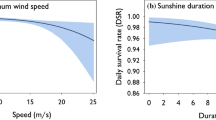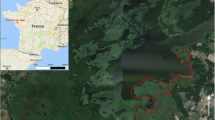Abstract
As shown for various species, nesting waders are non-randomly distributed on wetlands and preferentially select riparian nest-sites adjacent to limnic or marine waterbodies. Studying the redshank Tringa totanus, we tested the hypotheses that, in a coastal wader species which conceals its clutch in vegetation, predation and hatching success are affected by vegetation zonation, and that breeding in lower salt marsh areas has negative consequences for reproduction. We further predicted effects of timing of breeding and breeding experience/age of adults potentially reflected by egg biometrics both on nest-site selection and reproduction. Effects of vegetation, space, time and individual quality on hatching success of redshanks were studied in the German part of the Wadden Sea. Dominant plant species, vertical vegetation structure and nest concealment varied significantly between nests. Variation in nest concealment was relatively low: about 90% of clutches were classified as being well concealed. This variation was explainable by vegetation structure but not by vegetation composition at the nest-site, distance to shoreline, and time of clutch initiation. Vertical vegetation structure varied by dominant plant species but not by distance to shoreline and time of clutch initiation. Hatching success of clutches was low (10.6%) due to high predation (daily predation rate: 7.4%). Hatching success and duration of clutch survival were negatively and predation positively related to the date of clutch initiation. Furthermore, negative relationships were found between egg size and predation and duration of survival, respectively. We assume that concealed nests, early breeding and breeding experience diminish predation in salt marsh breeding redshanks. Thus, redshank reproduction appears to be affected by interactive effects of timing of breeding and vegetation facilitating early breeding. In contrast to open-nesting species, breeding in riparian habitats next to waterbodies may be disadvantageous for species breeding concealed in vegetation if these are covered by less structured vegetation.






Similar content being viewed by others
References
Backhaus K, Erichson B, Plinke W, Weiber R (1996) Multivariate Analysemethoden. Springer, Berlin Heidelberg NewYork
Bennett PM, Owens IPF (2002) Evolutionary ecology of birds. Oxford University Press, New York
Bernstein C, Krebs JR, Kacelnik A (1991) Distribution of birds amongst habitats: theory and relevance to conservation. In: Perrins CM, Lebreton J-D, Hirons GJM (eds) Bird population studies—Relevance to conservation and management. Oxford University Press, New York, pp 317–345
Braun-Blanquet J (1964) Pflanzensoziologie. Springer, Berlin Heidelberg NewYork
Burger J (1985) Habitat selection in temperate marsh-nesting birds. In: Cody ML (ed) Habitat selection in birds. Academic Press, San Diego, pp 253–281
Burhans DE, Dearborn D, Thompson FR, Faaborg J (2002) Factors affecting predation at songbird nests in old fields. J Wildl Manage 66: 240–249
Cody ML (1985) Habitat selection in birds. Academic Press, San Diego
Collias NE, Collias EC (1984) Nest building and bird behavior. Harvard University Press, Cambridge
Cresswell W (1997) Nest predation: the relative effects of nest characteristics, clutch size and parental behaviour. Anim Behav 53:93–103
Ellenberg H (1996) Vegetation Mitteleuropas mit den Alpen in ökologischer, dynamischer und historischer Sicht. Ulmer, Stuttgart
Ens BJ, Kersten M, Brenninkmeijer A, Hulscher JB (1992) Territory quality, parental effort and reproductive success of oystercatchers (Haematopus ostralegus). J Anim Ecol 61:703–715
Esselink P (2000) Nature management of coastal salt marshes. Koeman en Bijkerk bv, Haren
Exo K-M, Becker PH, Hälterlein B, Hötker H, Scheufler H, Stiefel A, Stock M, Südbeck P, Thorup O (1996) Bruterfolgsmonitoring bei Küstenvögeln. Vogelwelt 117:287–293
Glutz von Blotzheim UN, Bauer KM (1993) Handbuch der Vögel Mitteleuropas, Passeriformes (4. Teil). Aula-Verlag, Wiesbaden
Glutz von Blotzheim U-N, Bauer KM, Bezzel E (1977) Handbuch der Vögel Mitteleuropas, Charadriiformes (2. Teil). Akademische Verlagsgesellschaft, Wiesbaden
Götmark F (2002) Predation by sparrowhawks favours early breeding and small broods in great tits. Oecologia 130:25–32
Götmark F, Blomqvist D, Johansson OC, Bergkvist J (1995) Nest site selection: A trade-off between concealment and view of the surroundings? J Avian Biol 26:305–312
Green R (1984) Nomograms for estimating the stage of incubation of wader eggs in the field. Wader Study Group Bull 42:36–39
Großkopf G (1958) Zur Biologie des Rotschenkels (Tringa t. totanus) I. J Ornithol 99:1–17
Großkopf G (1959) Zur Biologie des Rotschenkels (Tringa t. totanus) II. J Ornithol 100:211–236
Großkopf G (1970) Der Einfluß von Alter und Partnerwahl auf das Einsetzen des Brutgeschäftes beim Rotschenkel Tringa totanus totanus. J Ornithol 111:420–437
Grover PB, Knopf FL (1982) Habitat requirements and breeding success of charadriiform birds nesting at salt plains national wildlife refuge, Oklahoma. J Field Ornithol 53:139–148
Hensler GL, Nichols JD (1981) The Mayfield method of estimating nesting success: a model, estimators and simulation results. Wilson Bull 93:42–53
Hildén O (1965) Habitat selection in birds. Ann Zool Fenn 2:53–75
Hoyt DF (1979) Practical method for estimating volume and fresh weight of bird eggs. Auk 96:73–77
Johnson DH (1979) Estimating nest success: the Mayfield method and an alternative. Auk 96:651–661
Jongmann RHG, ter Braak CJF, van Tongeren OFR (1995) Data analysis in community and landscape ecology. Cambridge University Press, Cambridge
Kokko H, Sutherland WJ (1998) Optimal floating and queuing strategies: consequences for density dependence and habitat loss. Am Nat 152:354–366
Lack D (1968) Ecological adaptations for breeding in birds. Methuen, London
Larivière S (1999) Reasons why predators cannot be inferred from nest remains. Condor 101:718–721
Mayfield H (1961) Nesting success calculated from exposure. Wilson Bull 73:255–261
Milsom TP, Langton SD, Parkin WK, Peel S, Bishop JD, Hart JD, Moore NP (2000) Habitat models of bird species’ distribution: an aid to the management of coastal grazing marshes. J Appl Ecol 37:706–727
Mühlenberg M (1989) Freilandökologie. Quelle & Meyer, Heidelberg
Newton I (1998) Population limitation in birds. Academic Press, San Diego
Niethammer J, Krapp F (1978) Handbuch der Säugetiere Europas, Rodentia I. Akademische Verlagsgesellschaft, Wiesbaden
Nilsson SG (1984) The evolution of nest-site selection among hole nesting birds: the importance of nest predation and competition. Ornis Scandinavica 15:167–175
Nilsson J-Å (1999) Fitness consequences of timing of reproduction. In: Adams NJ, Slotow RH (eds) Proc Int Ornithol Congr 22:234–247
Norris K, Cook T, O’Dowd B, Durdin C (1997) The density of Redshank Tringa totanus breeding on the salt-marshes of the Wash in relation to habitat and its grazing management. J Appl Ecol 34:999–1013
Oppermann R (1989) Ein Meßinstrument zur Ermittlung der Vegetationsdichte in grasig-krautigen Pflanzengesellschaften. Natur Landsch 64:332–338
Pott R (1992) Die Pflanzengesellschaften Deutschlands. Ulmer, Stuttgart
Rasmussen LM, Fleet DM, Hälterlein B, Koks BJ, Potel P, Südbeck P (2000) Breeding birds in the Wadden Sea in 1996. Wadden Sea Ecosystem 10. CWSS, Wilhelmshaven
Ricklefs RE (1969) An analysis of nesting mortality in birds. Smithson Contrib Zool 9:1–48
Sachs L (1997) Angewandte Statistik. Springer, Berlin Heidelberg New York
Sasvári L, Hegyi Z (2000) Avian predators influence the daily time budget of lapwings Vanellus vanellus. Folia Zool 49:211–219
Schmidt KA (1999) Foraging theory as a conceptual framework for studying nest predation. Oikos 85:151–160
Schmidt KA, Goheen JR, Naumann R (2001) Incidental nest predation in songbirds: behavioral indicators detect ecological scales and processes. Ecology 82:2937–2947
Stubbe M, Krapp F (1993a) Handbuch der Säugetiere Europas, Carnivora, Teil I: Canidae—Mustelidae 1. Aula, Wiesbaden
Stubbe M, Krapp F (1993b) Handbuch der Säugetiere Europas, Carnivora, Teil II: Mustelidae 2—Felidae. Aula, Wiesbaden
Summers RW, Underhill LG (1991) The relationship between body size and timing of breeding in Icelandic Redshanks Tringa t. robusta. Ibis 133: 134–139
Sutherland WJ (1996) From individual behaviour to population ecology. Oxford University Press, Oxford
Thompson PS, Hale WG (1989) Breeding site fidelity and natal philopatry in the Redshank Tringa totanus. Ibis 131:214–224
Thompson PS, Hale WG (1991) Age-related reproductive variation in the Redshank Tringa totanus. Ornis Scand 22:353–359
Thompson PS, McCarty C, Hale WG (1990) Growth and development of Redshank Tringa totanus chicks on the Ribble saltmarshes, N.W. England. Ringing Migration 11:57–64
Thyen S (1997) Habitatwahl und Schlüpferfolg des Rotschenkels (Tringa totanus) in landwirtschaftlich genutzten Salzrasen der niedersächsichen Küste. Vogelwarte 39:117–130
Thyen S (2000) Verteilung und Schlupferfolg von Brutvögeln in landwirtschaftlich genutzten Außengroden Niedersachsens. Seevögel 21:45–50
Thyen S, Exo K-M (2003) Ökofaunistik I - Brut- und Rastvögel. In: Flemming BW (ed) Untersuchung der ökologischen Entwicklung einer Außendeichskleipütte als Ergänzung der quantitativen Beweissicherung des Wiederverlandungsprozesses. Abschlussbericht: Senckenberg am Meer, Wilhelmshavenm, pp 49–98
Thyen S, Exo K-M (2004) Die Bedeutung von Salzrasen des niedersächsischen Wattenmeeres für die Reproduktion von Rotschenkeln Tringa totanus. In: Michael-Otto-Institut im NABU (ed) Schutz von Feuchtgrünland für Wiesenvögel in Deutschland. NABU, Bergenhusen, pp 20–26
Thyen S, Becker PH, Exo K-M, Hälterlein B, Hötker H, Südbeck P (1998) Monitoring breeding success of coastal birds. Wadden Sea Ecosystem 8:7–55
Thyen S, Exo K-M, Leyrer J (2002) Day- and night-time activity of Redshanks Tringa totanus breeding in Wadden Sea saltmarshes. Wader Study Group Bull 99:17
Tryjanowski P, Goldyn B, Surmacki A (2002) Influence of the red fox (Vulpes vulpes, Linnaeus 1758) on the distribution and number of breeding birds in an intensively used farmland. Ecol Res 17:395–399
Vickery PD, Hunter ML, Wells JV (1992) Evidence of incidental nest predation and its effects on nests of threatened grassland birds. Oikos 63:281–288
Weidinger K (2002) Interactive effects of concealment, parental behaviour and predators on the survival of open passerine nests. J Anim Ecol 71:424–437
Wisskirchen R, Haeupler H (1998) Standardliste der Farn- und Blütenpflanzen Deutschlands. Ulmer, Stuttgart
Acknowledgements
For their assistance during fieldwork and data processing, we would like to thank Rolf Nagel, Heike Büttger, Kerrin Lehn and Jutta Leyrer. Thanks also to Detlev Metzing and Albrecht Gerlach, University of Oldenburg, Germany, for co-operation and help with recording vegetation parameters. Peter H. Becker, Franz Bairlein, Birte Junge and Jutta Leyrer gave valuable comments on earlier drafts of the manuscript. Christine Frankovitch kindly checked the English. The Nationalparkverwaltung “Niedersächsisches Wattenmeer” gave permission to work on the salt marshes of the National Park. The study was supported by the III. Oldenburgischer Deichband, Jever, Germany. Many thanks to all of them.
Author information
Authors and Affiliations
Corresponding author
Additional information
Communicated by F. Bairlein
Rights and permissions
About this article
Cite this article
Thyen, S., Exo, KM. Interactive effects of time and vegetation on reproduction of redshanks (Tringa totanus) breeding in Wadden Sea salt marshes. J Ornithol 146, 215–225 (2005). https://doi.org/10.1007/s10336-005-0082-9
Received:
Revised:
Accepted:
Published:
Issue Date:
DOI: https://doi.org/10.1007/s10336-005-0082-9




